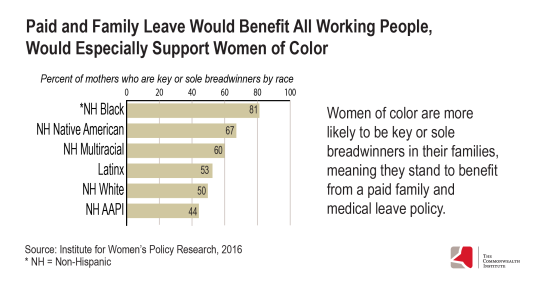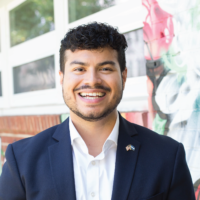August 22, 2019
For Women of Color, A Statewide Family and Medical Leave Program is Critical
Everyone should have the ability to care for themselves and loved ones without risking their paycheck. Nationwide, people agree: a recent survey found that 84% of voters support a comprehensive, national paid family and medical leave policy that all workers could access. The ability to take paid time off to care is important for everyone. But for communities of color, this opportunity is largely unavailable — only 25% of Latinx working people and 43% of Black working people in the United States report having access to some form of paid parental leave, compared to 50% of white working people. With no current national paid family and medical leave program, it’s important to take a closer look at how a statewide paid family and medical leave program could help to ensure that working people of every race have equal access to paid time off to care.
Seven states and D.C. have passed paid family and medical leave legislation, although Virginia isn’t one of them. There is currently a national protection in place — the 1993 Family and Medical Leave Act (FMLA) — but it only protects against job termination during a 12 week unpaid leave period and less than 60% of workers are eligible nationally. In Virginia, it’s estimated that over half of families are unable to take advantage of unpaid leave through FMLA because they don’t qualify or can’t afford to.
Due to historic and present-day barriers to wealth and economic mobility, Black, Latinx, and Native American families tend to experience higher rates of poverty and are paid less than average, which makes it even harder for members of these communities to access unpaid leave. Research also shows that in Virginia, 70% and 60% of Latinx and Black workers respectively are either ineligible or can’t afford to take unpaid FMLA leave. These structural, discriminatory barriers prevent families of color from being able to afford extended time off to care for themselves or their loved ones, which in turn puts their health and economic well-being in jeopardy. A statewide paid family and medical leave program would give more working families a chance at a healthier, more prosperous future.

A paid family and medical leave policy would be especially vital for the financial security of women and their families. Women of color would stand to benefit the most from a paid leave program — 81% of non-Hispanic Black mothers, 67% of non-Hispanic Native mothers, 60% of non-Hispanic multiracial or “other race” mothers, 53% of Latinx mothers, and 44% of non-Hispanic Asian American/Pacific Islander mothers are key or sole breadwinners for their families, compared to half of non-Hispanic white mothers. Being the breadwinner is made more difficult by the fact that, on average, women of color make lower wages than non-Hispanic white men. And women of color take on significant caretaking responsibilities: households headed by a person of color are more likely to be multi-generational, and women in general tend to be the primary caregivers in their families. Opting out of the workforce is often not an option, making the need for paid family and medical leave even more critical.
A statewide program would also have significant impacts on addressing health concerns that put communities of color at heightened risk. Research has found that people who are Black, Latinx, or Native American tend to have chronic health conditions, such as asthma, at higher rates and at a younger age than their white counterparts. This can impact their ability to remain in the workforce and highlights the need for paid medical leave so that people are able to take the time off to care for themselves in order to return to work. This policy could also protect the health of infants as paid leave has been strongly associated with fewer infant deaths (from birth to one year). In Virginia, Black, Latinx, and Asian/Pacific Islander families experience higher rates of infant mortality than non-Hispanic white families. The bottom line: a statewide paid family and medical leave program gives families of color a healthier beginning.
California’s state paid family and medical leave program — the longest running in the country — has resulted in measurable success for people of color as well as businesses. After 10 years of the program, a study found that nine out of 10 employers reported that paid leave had either a positive effect or no effect on employee productivity, performance, and profits. Most employers also reported no added costs after the implementation of the policy, and 9% even reported cost savings. Another study noted that California’s program allowed for Black women to take leave equal to white women. Prior to the program, Black women took an average of one week of maternity leave, while white non-Hispanic women took an average of four weeks. After the program was put in place, both Black and white women took an average of seven weeks paid leave, giving families more time to bond with their children. And research by the Urban Institute showed that the positive effects of paid family and medical leave in California appear to be the strongest for mothers with lower levels of education and mothers of color.
While the focus is often on how paid family and medical leave can help women — and there is strong evidence to show these benefits — paid family and medical leave could benefit anyone, such as those who have been injured, new fathers, and those caring for a family member who is ill. At the state level, three proposals were brought to the 2019 General Assembly session: SB1639 by Sen. Boysko, HB2120 by Del. Carroll Foy, and HB2261 by Del. Guzman. Two of the three proposals would have allowed 12 weeks paid leave for working people in Virginia and provided about 70% of a worker’s weekly wage (not to exceed $850 a week). While none of the bills were passed by the legislature, discussion about the proposed policy resulted in a bipartisan agreement to form a work group to further study the issue. Legislators should look closely at the research that shows the benefits of paid family and medical leave and gather learnings from other states to craft a paid family and medical leave policy that works for Virginia. All working people in Virginia, regardless of race and income, should be able to take the time needed to care for themselves and their loved ones without risking their financial security.
Category:
Economic Opportunity

